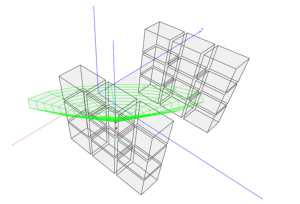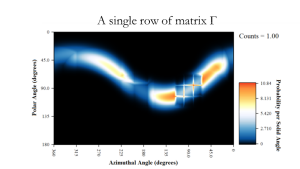The Orion research group’s core technology is the Polaris architecture. Polaris is a gamma-ray imaging spectrometry system that is composed of one or more 3-dimensional position sensitive semiconductor radiation detectors. The 3-dimensional event reconstruction (including the x, y, z interaction position and energy deposition) allows for improved energy resolution, as well as real-time gamma-ray imaging.
The original Polaris system is an 18-detector Cadmium Zinc Telluride (also known as CZT) array system designed by the University of Michigan using analog readout electronics developed by Gamma Medica-Ideas, Inc. and detectors from Redlen Technologies, Inc. Each of the 18 detectors is cubic in shape with dimensions 20 mm x 20mm x 15 mm. All system design and integration is performed by students and researchers in the Orion group. Data acquisition and analysis software is also written in house.
We are continuously making incremental improvements to our system; the original system built in 2010 achieved 1.5% FWHM at 662 keV for all events combined. The second system was built in June 2011 and achieved 1.2% FWHM at 662 keV for all events combined. The second-generation prototype system was built in 2012 in collaboration with H3D, Inc. (an Ann Arbor startup company employing several past Orion members), Brookhaven National Laboratory (developers of the next-generation analog readout electronics), and LocoLabs, LLC (responsible for rapid-prototype design of the integrated system). Due to improvements in the readout electronics, these systems achieve 0.9% FWHM at 662 keV for all events combined. Further reduction in front-end electronic noise and improvement in crystal material contribute to increased spectroscopic performance. As of 2017, the latest system under development has demonstrated 0.51% FWHM for all events. This system has also achieved 0.34% FWHM for single-pixel events under ideal, spectroscopic configurations.
The group consists of three primary focuses. The first of which develops the digital ASIC readout for current systems and implements gamma-ray event reconstruction techniques. The second focus pertains to image reconstruction techniques. This team is responsible for improving gamma-ray and neutron imaging performance. This includes a wide variety of algorithms, including but not limited to simple back-projection, filtered back-projection, maximum-likelihood expectation maximization, stochastic origin ensembles and time-encoded imaging. Alongside the digital ASIC team, the alternative materials team explores alternative gamma-ray imaging spectrometers using TlBr while working with Lawrence Livermore National Laboratory and Radiation Monitoring Devices. They also explore CsPbBr3, CdZnTeSe, MAPbBr3, and other materials.
For a better understanding of how this technology works and the chronology of its development, please see our Publications section.


